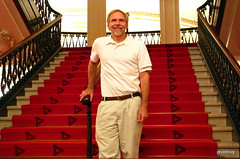
I'm fascinated by the art of classical composition, even though I don't know much about the true aspects beyond mere development. I'm often in awe of composers for their ability to hear in their mind's ear what the composition would be without actually hearing, this is such a unique ability.
American music composed by American composers, that is the theme this weekend at the PSO. The quintessential of those composers is Copland. The PSO performed the two selections by Copland beautifully! Additionally, John William's horn concerto with soloist William Caballero was a great new piece for me to hear. The English Horn is such a mellow and pleasing instrument, and this was an inspiring composition to highlight the horn as well as the percussion (see photo). These elements all brought a smile to my face.
I'd say the penultimate of the very best compositions by an American composer must be the Adagio by Barber, in that you would present this last in the credits, as if making a special guest appearance of an important piece, but not to imply that this piece comes last or even next to last, but that it is indeed special. I place it high above most compositions because of its romantic and stirring emotional flavor. It is classical in nature, and for me has the classical European feel to it; and it is quite simple in form, yet stirring and powerful. This all-strings piece completely filled Heinz Hall with such verve and strident harmonious ardor, it's eagerness and enthusiasm completely overwhelmed my sense of dulcet euphoria, and this only begins to describe the elation of a sound that transcends hearing.







